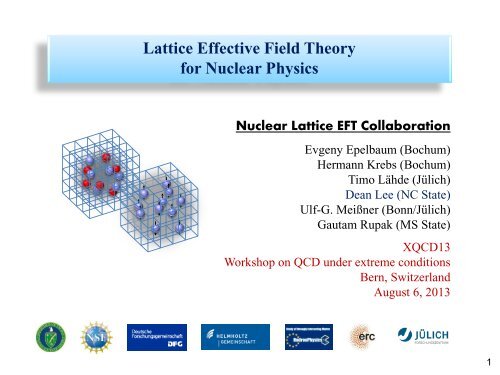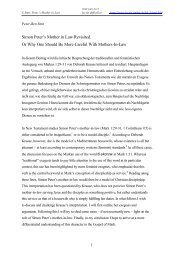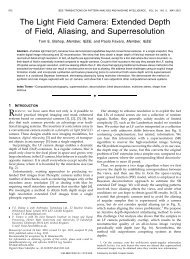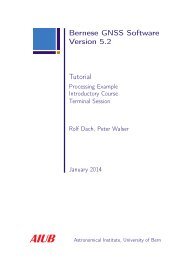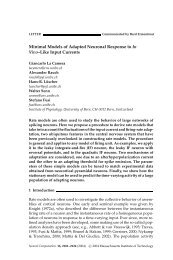Lattice Effective Field Theory for Nuclear Physics - XQCD13
Lattice Effective Field Theory for Nuclear Physics - XQCD13
Lattice Effective Field Theory for Nuclear Physics - XQCD13
You also want an ePaper? Increase the reach of your titles
YUMPU automatically turns print PDFs into web optimized ePapers that Google loves.
<strong>Lattice</strong> <strong>Effective</strong> <strong>Field</strong> <strong>Theory</strong><br />
<strong>for</strong> <strong>Nuclear</strong> <strong>Physics</strong><br />
<strong>Nuclear</strong> <strong>Lattice</strong> EFT Collaboration<br />
Evgeny Epelbaum (Bochum)<br />
Hermann Krebs (Bochum)<br />
Timo Lähde (Jülich)<br />
Dean Lee (NC State)<br />
Ulf-G. Meißner (Bonn/Jülich)<br />
Gautam Rupak (MS State)<br />
<strong>XQCD13</strong><br />
Workshop on QCD under extreme conditions<br />
Bern, Switzerland<br />
August 6, 2013<br />
1
Outline<br />
Introduction and motivation<br />
What is lattice effective field theory?<br />
<strong>Lattice</strong> results <strong>for</strong> light nuclei<br />
Carbon-12 spectrum and the Hoyle state<br />
Light quark mass dependence of helium burning<br />
Scattering and reactions on the lattice<br />
Summary and future directions<br />
2
Elemental composition of the human body by mass<br />
Where did it come from?<br />
How was it made?<br />
3
Big bang nucleosynthesis<br />
4
Stellar nucleosynthesis<br />
5
Simulation as the next generation microscope<br />
q<br />
q<br />
q<br />
6
<strong>Lattice</strong> quantum chromodynamics<br />
u<br />
p<br />
d<br />
u<br />
7
<strong>Lattice</strong> effective field theory<br />
n<br />
n<br />
p<br />
n<br />
p<br />
8
T [MeV]<br />
Accessible by<br />
<strong>Lattice</strong> QCD<br />
100<br />
early<br />
universe<br />
quark-gluon<br />
plasma<br />
10<br />
1<br />
gas of light<br />
nuclei<br />
neutron star crust<br />
nuclear<br />
liquid<br />
superfluid<br />
heavy-ion<br />
collisions<br />
Accessible by<br />
<strong>Lattice</strong> EFT<br />
excited<br />
nuclei<br />
neutron star core<br />
10 -3 10 -2 10 -1 1<br />
r [fm -3 ] r N<br />
9
Low energy nucleons: Chiral effective field theory<br />
Construct the effective potential order by order<br />
N<br />
N<br />
N<br />
N<br />
N<br />
N<br />
N<br />
N<br />
p<br />
p<br />
p<br />
N<br />
N<br />
N<br />
N<br />
N<br />
N<br />
N<br />
N<br />
Contact interactions<br />
Leading order (LO)<br />
Next-to-leading order (NLO)<br />
10
<strong>Nuclear</strong><br />
Scattering Data<br />
<strong>Effective</strong><br />
<strong>Field</strong> <strong>Theory</strong><br />
Ordonez et al. ’94; Friar & Coon ’94;<br />
Kaiser et al. ’97; Epelbaum et al. ’98,‘03;<br />
Kaiser ’99-’01; Higa et al. ’03; …<br />
11
Leading order on the lattice<br />
p<br />
n<br />
p<br />
12
Next-to-leading order on the lattice<br />
p<br />
p<br />
p<br />
p<br />
p<br />
p<br />
. . .<br />
13
Physical<br />
scattering data<br />
Unknown operator<br />
coefficients<br />
Spherical wall method<br />
Borasoy, Epelbaum, Krebs, D.L., Meißner,<br />
EPJA 34 (2007) 185<br />
Spherical wall imposed in the center of mass<br />
frame<br />
R wall<br />
14
LO 3 : S waves<br />
15
LO 3 : P waves<br />
16
Three nucleon <strong>for</strong>ces<br />
Two unknown coefficients at NNLO from three-nucleon <strong>for</strong>ces.<br />
Determine c D and c E using 3 H binding energy and the weak axial current<br />
at low cutoff momentum.<br />
c 1, c 3, c 4<br />
c D<br />
c 1, c 3, c 4<br />
c E<br />
c D<br />
17<br />
Park, et al., PRC 67 (2003) 055206,<br />
Gårdestig, Phillips, PRL 96 (2006) 232301,<br />
Gazit, Quaglioni, Navratil, PRL 103 (2009) 102502
Neutrons and protons: Isospin breaking and Coulomb<br />
Isospin-breaking and power counting [Friar , van Kolck, PRC 60 (1999)<br />
034006; Walzl, Meißner, Epelbaum NPA 693 (2001) 663; Friar, van<br />
Kolck, Payne, Coon, PRC 68 (2003) 024003; Epelbaum, Meißner, PRC72<br />
(2005) 044001…]<br />
Pion mass difference<br />
18
Coulomb potential<br />
p<br />
p<br />
Charge symmetry breaking<br />
Charge independence breaking<br />
p<br />
p<br />
n<br />
p<br />
n<br />
n<br />
19
Triton and Helium-3<br />
20
Euclidean time projection<br />
p<br />
p<br />
21
Auxiliary field method<br />
We can write exponentials of the interaction using a Gaussian integral<br />
identity<br />
We remove the interaction between nucleons and replace it with the<br />
interactions of each nucleon with a background field.<br />
22
Schematic of lattice Monte Carlo calculation<br />
Hybrid Monte Carlo sampling<br />
24
Ground state of Helium-4<br />
Epelbaum, Krebs, D.L, Meißner, PRL 104 (2010) 142501;<br />
EPJA 45 (2010) 335; PRL 106 (2011) 192501<br />
26
Ground state of Helium-4<br />
LO* (O(Q 0 ))<br />
NLO (O(Q 2 ))<br />
NNLO (O(Q 3 ))<br />
Experiment<br />
-24.8(2) MeV<br />
-23.8(2) MeV<br />
-28.4(3) MeV<br />
-28.3 MeV<br />
*contains some interactions promoted from NLO<br />
27
Ground state of Beryllium-8<br />
Epelbaum, Krebs, D.L, Meißner, PRL 106 (2011) 192501<br />
28
Ground state of Beryllium-8<br />
LO* (O(Q 0 ))<br />
NLO (O(Q 2 ))<br />
NNLO (O(Q 3 ))<br />
Experiment<br />
-60.9(7) MeV<br />
-55(2) MeV<br />
-58(2) MeV<br />
-56.5 MeV<br />
*contains some interactions promoted from NLO<br />
29
Particle clustering included automatically<br />
30
Carbon-12 spectrum and the Hoyle state<br />
31
Ground state of Carbon-12<br />
Epelbaum, Krebs, D.L, Meißner, PRL 106 (2011) 192501<br />
Epelbaum, Krebs, Lähde, D.L, Meißner, PRL 109 (2012) 252501<br />
32
Ground state of Carbon-12<br />
LO* (O(Q 0 ))<br />
NLO (O(Q 2 ))<br />
NNLO (O(Q 3 ))<br />
Experiment<br />
-96(2) MeV<br />
-77(3) MeV<br />
-92(3) MeV<br />
-92.2 MeV<br />
*contains some interactions promoted from NLO<br />
See also strong coupling lattice QCD results <strong>for</strong> carbon-12:<br />
De Forcrand, Fromm, PRL 104 (2010) 112005<br />
33
Simulations using general initial/final state wavefunctions<br />
Construct states with well-defined momentum using all possible<br />
translations.<br />
34
Shell model wavefunctions<br />
Alpha cluster wavefunctions<br />
35
Carbon-12<br />
0 1<br />
+<br />
0 2<br />
+<br />
Epelbaum, Krebs, Lähde, D.L, Meißner, PRL 109 252501 (2012)<br />
36
Structure of ground state and first 2+<br />
Strong overlap with compact triangle configuration<br />
12 rotational<br />
orientations<br />
37
Structure of Hoyle state and second 2+<br />
Strong overlap with bent arm configuration<br />
24 rotational<br />
orientations<br />
38
Excited state spectrum of carbon-12 (even parity)<br />
LO* (O(Q 0 )) -94(2) MeV -89(2) MeV -88(2) MeV<br />
NLO (O(Q 2 )) -74(3) MeV -72(3) MeV -70(3) MeV<br />
NNLO (O(Q 3 )) -89(3) MeV -85(3) MeV -83(3) MeV<br />
Experiment -87.72 MeV -84.51 MeV<br />
-82.6(1) MeV (A,B)<br />
-81.1(3) MeV (C)<br />
-82.13(11) MeV (D)<br />
*contains some interactions<br />
promoted from NLO<br />
A – Freer et al., PRC 80 (2009) 041303<br />
B – Zimmerman et al., PRC 84 (2011) 027304<br />
C – Hyldegaard et al., PRC 81 (2010) 024303<br />
D – Itoh et al., PRC 84 (2011) 054308<br />
Epelbaum, Krebs, Lähde, D.L, Meißner, PRL 109 252501 (2012)<br />
39
Light quark mass dependence of helium burning<br />
40
Triple alpha reaction rate<br />
EM width G g<br />
Alpha density N a Temperature T<br />
Hoyle relative to triple-alpha<br />
41
Is nature fine-tuned?<br />
Less resonance enhancement.<br />
Rate of carbon production smaller<br />
by several orders of magnitude.<br />
Low carbon abundance is<br />
unfavorable <strong>for</strong> carbon-based life.<br />
Carbon production occurs at<br />
lower stellar temperatures and<br />
oxygen production greatly reduced.<br />
Low oxygen abundance is<br />
unfavorable <strong>for</strong> carbon-based life.<br />
Schlattl et al., Astrophys. Space Sci., 291, 27–56 (2004)<br />
We investigate the dependence on the fundamental parameters of the standard<br />
model such as the light quark masses. Can be parameterized by the pion mass.<br />
42
Figure courtesy of U.-G. Meißner<br />
Epelbaum, Krebs, Lähde, D.L, Meißner, PRL 110 (2013) 112502; EJPA 49 (2013) 82;<br />
Berengut et al., Phys. Rev. D 87 (2013) 085018<br />
43
<strong>Lattice</strong> results <strong>for</strong> pion mass dependence<br />
44
Hoyle relative to Be-8-alpha<br />
Be-8 relative to alpha-alpha<br />
Hoyle relative to triple-alpha<br />
Epelbaum, Krebs, Lähde, D.L, Meißner, PRL 110 (2013) 112502; EJPA 49 (2013) 82;<br />
Berengut et al., Phys. Rev. D 87 (2013) 085018<br />
45
Evidence <strong>for</strong> correlation with alpha binding energy<br />
a<br />
Epelbaum, Krebs, Lähde, D.L, Meißner, PRL 110 (2013) 112502; EJPA 49 (2013) 82<br />
46
“End of the world” plot<br />
Epelbaum, Krebs, Lähde, D.L, Meißner, PRL 110 (2013) 112502; EJPA 49 (2013) 82<br />
47
Scattering and reactions on the lattice<br />
Projected adiabatic matrix method<br />
Using cluster<br />
wavefunctions<br />
<strong>for</strong> initial<br />
continuum<br />
scattering states<br />
48
Use projection Monte Carlo to propagate cluster wavefunctions in<br />
Euclidean time<br />
Construct a norm matrix and matrix of expectation values<br />
49
Compute the projected adiabatic matrix<br />
Projected adiabatic Hamiltonian is now an effective two-body<br />
Hamiltonian. Similar in spirit to no-core shell model with resonating<br />
group method.<br />
But some differences. Distortion of the nucleus wavefunctions is<br />
automatic due to projection in Euclidean time.<br />
Rupak, D.L., PRL 111 (2013) 032502; Pine, D.L., Rupak, work in progress<br />
50
Example: Quartet neutron-deuteron scattering<br />
Pine, D.L., Rupak, work in progress<br />
51
Quartet neutron-deuteron scattering (pionless EFT at LO)<br />
Pine, D.L., Rupak, work in progress<br />
52
Use coupled channels <strong>for</strong> capture reactions and break up processes.<br />
<strong>Lattice</strong> Green’s function methods <strong>for</strong> radiative capture tested <strong>for</strong><br />
n + p d + g in pionless effective field theory at leading order.<br />
Elastic scattering amplitude ( 1 S 0 and 3 S 1 )<br />
M1 radiative capture amplitude<br />
1<br />
S 3<br />
S 1<br />
0 1 S 3<br />
0 S 1<br />
Rupak, D.L., PRL 111 (2013) 032502<br />
53
M1 transition amplitude n + p d + g<br />
d = infrared regulator<br />
Exact continuum<br />
results <strong>for</strong> comparison<br />
Rupak, D.L., PRL 111 (2013) 032502<br />
54
Summary<br />
A golden age <strong>for</strong> nuclear theory from first principles. Big science<br />
discoveries being made and many more around the corner.<br />
<strong>Lattice</strong> effective field theory is a relatively new and promising tool<br />
that combines the framework of effective field theory and<br />
computational lattice methods. May play a significant role in the<br />
future of ab initio nuclear theory.<br />
Topics being addressed now and in the near future…<br />
Different lattice spacings, N Z nuclei, neutron matter equation of<br />
state and superfluid transition from S-wave to P-wave, ground state<br />
nuclei up to A = 28, structure and spectrum of oxygen-16, etc.<br />
55


